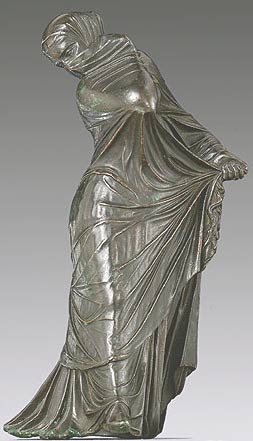|
|
“The Little Refugee” was found in 1922 in Gerontiko in Nissas (Asia Minor) by the archaeologist Konstantinos Kourouniotis and was brought to the National Museum in Athens in the first days of the destruction of Smyrna, August 1922. It dates from first century BC but was probably a copy from an earlier work from third century BC. THE END William Smith, A Dictionary of Greek and Roman Antiquities, John Murray, London, 1875. p 220.
Statuette of a veiled and masked dancer, 3rd–2nd century B.C.; Hellenistic Greek Bequest of Walter C. Baker, 1971 (1972.118.95) The dancer wears a chiton and a himation, which are described in rich contrasts of texture, weight and mass. The long chiton reaches the floor, where it falls in regular, deep and tubular folds, which spread out like a peacock’s tail, trailing behind the dancer and balancing the tilted head and the extended forward left arm. The mantle is smooth, shiny, light and transparent. Its diaphanous quality is carefully depicted: the overfold of the chiton, as well as the cord around the waist, show through at the hip. Thus a contrast is created between the horizontal, protruding and diverging folds of the himation and the vertical, deep and parallel folds of the chiton worn underneath. The back view shows long fringes, which seem to flutter behind the dancer as a result of her swift turning, Elisabet Friesländer , The Mantle Dancer in the Hellenistic Period: Glorification of the Himation. .Alcmaeon Son of Megacles: On his arrival at Sardis, Croesus made him a present of as much gold as he could carry out of the treasury. Alcmaeon took the king at his word, by putting on a most capacious dress, the folds of which (as well as the vacant space of a pair of very wide boots, also provided for the occasion) he stuffed with gold, and then filled his mouth and hair with gold dust. Croesus laughed at the trick. Materials Cotton , Linen, Flax , Silk , Dyes See also: LINKS Ancient Greek Dress (Metropolitan Museum) The Goddess. Pandora's Box: The Chiton, Peplos, and Himation Today! (Ancient Greek Fashion for the modern woman) THE HISTORY OF COSTUME - INDEX By Braun & Schneider – c.1861-1880 The Cleopatra Costume on Stage and in Film Ancient Greek Fashion for Centaurs See also: Roman Clothing Part 1 , Roman Clothing Part 2 (Contains also information about the Peplos and the Chiton) Ancient Roman Bikinis , Roman Shoes The Clothed Body in the Ancient World (A conference in the UK) BOOKS Goddess: The Classical Mode; By Harold Koda exhibition catalogue for the Metropolitan Museum of Art costume institute. It shows the influence of ancient Greek and Roman fashion in more modern times on women's costume William Smith, A Dictionary of Greek and Roman Antiquities, John Murray, London, 1875
 |
|||||||||||||||

